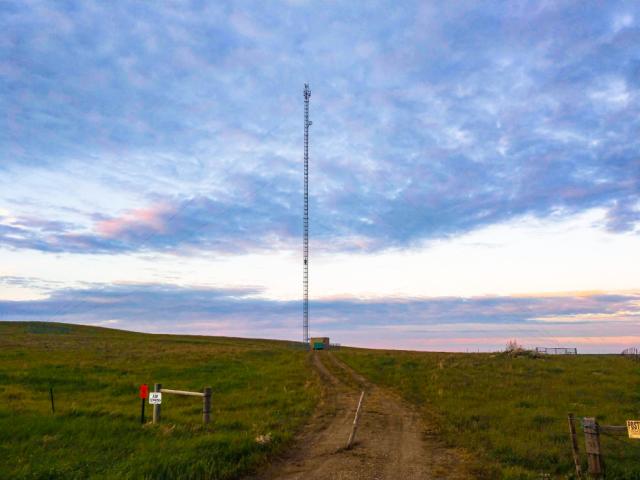
A cell tower in one of Infrastructure Network’s rural coverage areas, which include the Permian, Eagle Ford, Bakken and SCOOP/STACK. (Source: Infrastructure Networks)
[Editor's note: A version of this story appears in the August 2020 edition of Oil and Gas Investor. It was originally published May 20, 2020. Subscribe to the magazine here.]
Oil and gas operators increasingly recognize that data, the vast, nonphysical resource gathered as part of exploration and production, is critical to their success. The growing presence of data analytics firms in the sector confirms this. So far, so good, and the digital transformation of oil and gas marches along—assuming that operators can get their field data efficiently, reliably and securely from facilities at the remotest edge of connectivity to an office where an analyst can process it.
To address this need, Infrastructure Networks (INET), a Houston-based technology and telecommunications company, offers a service: the oil and gas industry’s first end-to-end, private licensed wireless network, now covering 130,000 square miles of oilfield, including the Permian Basin, Eagle Ford, Bakken and Scoop/Stack. The industry’s only provider of private Long Term Evolution (LTE) infrastructure and service, INET can alleviate the strain on capex that companies face when they build their own networks. Instead, in any of these areas, oil and gas customers can buy into INET’s existing coverage. INET retains ownership of the network, but each customer receives its functionality privately and securely.

INET promises upward of 99% reliability in its service-level agreements and can deploy its network immediately, granting “plug and play” connectivity for applications ranging from geosteering and drilling data collection to SCADA or video monitoring.
“The idea is that you don’t have to be at the edge as often or at all,” INET CEO Mark Slaughter said. “You can use our technologies both for automation and sensors and actuators, but you can also remotely monitor that from the office to a greater degree as we go forward. Your decision makers, your expertise … can be at the office covering more than one site, and that productivity and lifestyle improvement, we think, will take the industry to a new level.”
Telecom free-for-all
INET recently upgraded its network to become 5G-capable, preparing for the industry to adopt the next generation of telecommunications technology. However, INET’s network service precedes this latest communications standard, having originated with the emergence and evolution of 4G LTE in early 2010.
After observing the limited network technologies at several remote oil fields in California, INET founder and CTO Stan Hughey saw an opportunity to “leapfrog the state of the art in the [oil and gas] industry” by introducing recent 4G developments to the industry, he said.
At the time, companies were diverting significant capital toward building and maintaining their own private communications networks. In addition, many were operated “on an unlicensed or shared spectrum, which means they would go into a geographical space and deploy their own capital, their own networks, and compete for a shared, common spectrum resource,” Hughey said.
Unlicensed radio spectrum has no protection against interference from other users, and the frequency bands designated by the Federal Communications Commission (FCC) for unlicensed operation—all above 900 MHz—are more difficult to propagate, especially in rural areas, limiting coverage.
The resulting free-for-all over unlicensed spectrum entailed competition for a resource that deteriorated with additional users.
Beyond oil and gas, the FCC had granted some organizations rights to licensed spectrum, which includes legal protection and enforcement to prevent interference, “particularly reused television spectrum in the 700 MHz range,” Hughey said. “That operates very well in a rural environment; it propagates.”
In April 2011, Hughey formed INET to “acquire those [spectrum] licenses over the major shale plays and build a network that we basically had complete control of and built from the ground up to serve the industry,” he said.
Since first validating the network technology in the Permian, INET has received significant support from the industry and investors. Altira Group LLC, a Denver-based venture capital firm, made an investment in September 2012, followed by a significant investment by Apollo Global Management Inc. in 2018. “Apollo’s capital was used this past year to really expand and deepen the network,” Slaughter said, adding that it also facilitated the network upgrade to 5G capability.
Focusing capital and expertise
Freedom from the need to develop a private network allows oil and gas companies to commit more capital and expertise to their drilling and production programs. Present market conditions pull operators’ attention in myriad directions, placing new demands on managerial skillsets and budgets, so it behooves companies, now more than ever, to consider means of attaining greater network capabilities without further dividing their resources.

Building one’s own network involves a two-fold investment: the initial capital investment to construct it and the ongoing operating cost to maintain and update it. INET, on the other hand, manages its already existing network’s maintenance and development on behalf of its oil and gas clients. Customers simply receive an invoice, which, in some instances, provides a 3:1 cost difference, Hughey said.
“We have actually seen specific cases, since we’ve been doing this for 10 years now, where over a total cost of ownership 10-year term … every dollar spent with us would require an operator to spend about three dollars to get a similar level of connectivity,” he said.
INET’s service can facilitate expertise efficiencies, too. To build their own networks, Slaughter said companies “are having to develop expertise, having to build out skillsets in the company that are communications related ... and the knowledge to keep those network technologies current.” Given some companies’ lean human resources, this risks drawing the attention of valuable personnel away from core operation areas.
In contrast, “As a [telecommunications] company completely focused on the oil and gas industry in those basins, we make those investments [of capital and expertise] for companies,” he said.
Slaughter added that INET works with companies of varied sizes, ranging “from major operators that are moving more aggressively to progressive independents to small oil and gas operators. They’re all going through digital transformations” that require more connectivity.
Proof in the Permian
For example, INET was critical to such a transformation for Noble Energy Inc. in the Permian. After acquiring Clayton Williams Energy Inc. in 2017, Noble needed to establish a reliable network to well sites without standardized network technology. To do this, it partnered with INET. According to Brandon Wise, business analyst–operations technology at Noble, who led the effort to update the new assets’ technological capabilities, INET offered the most complete service.
Wise highlighted how INET’s IP-based network has enhanced Noble’s visibility to well conditions. In terms of automated polling data, he said that “We’ve moved from the industry average of 15 to 20 minute polling—basically, pinging the device and saying, ‘every 15 minutes, give me a number,’ to on [INET’s network] doing 1 to 2 minute polling.
“The production engineers love it, especially for new wells and electronic submersible pumps. They can get instant feedback on adjustments they make while trying to optimize a well’s production.”
On older, serial radio networks—the most commonly used in the oilfield today—it takes significant time to send and receive data, and operators risk potential data loss if a missed poll occurs, which can prove especially problematic, even dangerous, in situations where an operator might need to remotely shut in a well.
However, on INET’s network, Noble is able to see “if there are any leading indicators that we need to turn off a well” before onsite emergency shut down equipment kicks in, Wise said. This allows the control room operator to remotely shut-in wells when necessary, “which is critical from a safety and environmental perspective.”
Noble now uses “INET for every one of our well sites in the field throughout the Permian; we use them for our man camps and one of our offices out there; and our midstream uses them for five or six central gathering facilities and terminals,” Wise said.
Despite the scope of network implementation, Noble is in fact one of the aforementioned 3:1 cases. “From a cost standpoint, it would have cost about three times as much and taken three times longer to build [this network] ourselves,” Wise said.
“Also, the flexibility it gives us is invaluable,” he added. “If we acquire a new acreage position or wells in a different part of the basin, all we have to do is setup a new LTE radio and have everything online in a matter of days compared to spending several months designing and installing our own infrastructure.”
Though not a foreseen benefit of partnering with INET, Noble has found that the flexibility of the company’s network has allowed them to continue to integrate new assets during the COVID-19 pandemic. Many factories have delays up to several months in providing the equipment needed for a company to build out a personal network, Wise said, making INET’s already established equipment vital.
Noble is interested in additional INET services, Wise said, specifically remote wellsite monitoring. In order to get workers off the roads and out of the field, he said, “Our next step with INET is … doing remote wellsite visits” with pan-tilt-zoom cameras.
This would enable technicians “to go through a guy’s route, as if they were onsite … and just go through [lower risk sites] on their computer,” he explained. The time saved by not having to drive to every well site “can be spent optimizing existing wells or focusing on other alarms, preventative maintenance” and other critical tasks.
Of these advancements, they’re “just impossible” with non-IP technology, Wise said, adding that a network built “the way networks always have been for the last 30 years won’t set us up for future opportunities.”
Two paths for 5G
According to INET’s Hughey, the proprietary technologies that companies often use to develop their own networks generally, and increasingly, risk obsolescence. They are proving insufficient for “emerging use cases for data science, advanced artificial intelligence and connectivity of the enterprise out to the edge, as a way to remove workers from the field,” he said.
And this risk will grow as the industry embraces the 5G standard, which promises significant rewards and is significant to INET’s growth plans.
“5G standards have hit a fork in the road with a split between low-power, wide-area sensor type connectivity, what you think of as Internet of Things (IoT) applications, and then they’ve also split into ultrabroadband, which are the gigabit speeds to your LTE radio and connectivity,” Hughey said.
Regarding the IoT path, he said, “INET can push out very low-cost connectivity to sensors that can run on batteries for years at a time. They don’t need SCADA infrastructure in between them; [customers] can stick a sensor out there, and it can plug directly into our network.”
Oil and gas operators’ sensor networks continue to grow, potentially including millions of endpoints, and that growth poses challenges for managing battery life, device health, etc. Through its 5G low-power connectivity, which is already available to clients, “INET is allowing customers to manage that number of devices,” Hughey said.
Of course, “There’s also the ultrabroadband side, where we can deploy a 5G small cell, the same type you see Verizon or AT&T deploying in a downtown metropolitan area,” he continued. For the companies that utilize them, these cells will enable gigabit speeds directly at and around the well site, hundreds of miles from anything like city traffic and shopping malls.

Yet much like in some urban areas, where consumers and businesses benefit from rapid fiber connections, fiber-optic cables form the intermediate links, or backhaul, between remote facilities and corporate offices. “We have a lot of operators actively deploying fiber to their major facilities out in the field,” Hughey said. “At the end of those fiber connections, we’ll be able to put 5G services.”
These two paths for 5G converge into “a unified communications solution,” Slaughter said. “Gigabit speed at the well pad via 5G; at the other extreme are 5G standards for narrowband industrial internet, which can be across the basin; and then our standard 4G broadband will still be there for general communications at a megabit speed across the basin.”
A neutral player
INET aims to streamline collaboration between operators and their subcontractors, such as drillers or frac crews, and with other technological partners, and the growth of its network can benefit operators at a basin-wide level.
“That’s something that gets lost on a lot of oil and gas companies when they build their own private networks: They really are closed networks” that prevent third parties from leveraging their benefits, Hughey said. He added that operator-specific communications hardware, security concerns and regulations have “really stifled adoption [of new technology] in the past.”
Referring to the growing platform of companies offering digital services, including video and chemical monitoring as well as data analytics, he said INET “allows them to take off-the-self, standard hardware, deploy it out there and begin serving their customers immediately.”
This is analogous to “what the smartphone has done for app store,” he said. “It’s given you a platform on which all these applications and service reside. We’re not the platform, but we’re providing connectivity into [it.]”
“We act as a neutral player, in bringing all those parties together,” Slaughter said, pointing toward INET’s partnerships with advanced analytics providers in particular.
“We can help these small [analytics] companies, each of whom are helping the industry evolve and innovate ... scale very quickly across our network and across our installed customer base in ways that can be very difficult for them to do alone,” he said.
He explained, “We can measure [data usage at the well site], at least for rigs in the Permian. This past year the average rig has really used almost a terabyte of data over the course of an average month.” The amount of data used grows rapidly, he added.
Slaughter said that research suggests that the data currently transiting to/from rigs for analysis represents only about one percent of all data actually generated at the site. “As more people figure out what information they need for decision-making, we think the more they’ll seek to transmit that to decision makers in the office,” he said.
“That’s the opportunity we have—to help meet those critical data transmission needs reliably and robustly,” he said. “Our partners and advanced analytic providers turn that data into information and insights to drive better decision making.”
Slaughter said, “We play that critical role: If you can’t get [data] back to the office, it can’t be analyzed.”
Recommended Reading
Range Resources Holds Production Steady in 1Q 2024
2024-04-24 - NGLs are providing a boost for Range Resources as the company waits for natural gas demand to rebound.
Hess Midstream Increases Class A Distribution
2024-04-24 - Hess Midstream has increased its quarterly distribution per Class A share by approximately 45% since the first quarter of 2021.
Baker Hughes Awarded Saudi Pipeline Technology Contract
2024-04-23 - Baker Hughes will supply centrifugal compressors for Saudi Arabia’s new pipeline system, which aims to increase gas distribution across the kingdom and reduce carbon emissions
PrairieSky Adds $6.4MM in Mannville Royalty Interests, Reduces Debt
2024-04-23 - PrairieSky Royalty said the acquisition was funded with excess earnings from the CA$83 million (US$60.75 million) generated from operations.
Equitrans Midstream Announces Quarterly Dividends
2024-04-23 - Equitrans' dividends will be paid on May 15 to all applicable ETRN shareholders of record at the close of business on May 7.





